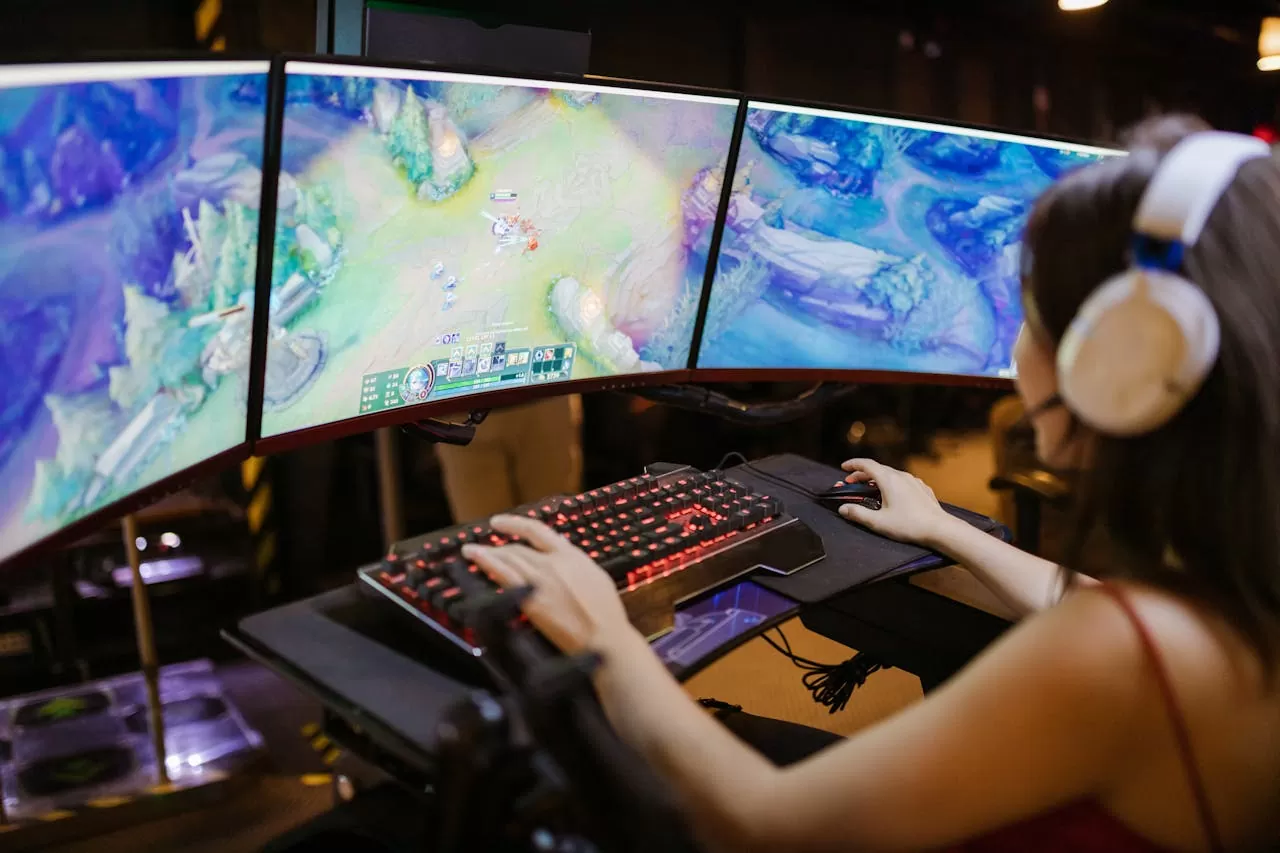Is it really possible to make a living playing video games? This question, once met with skeptical smiles, now finds a resounding “yes” in today’s expanding market. In 2025, the gaming industry represents over $200 billion globally, offering numerous opportunities to transform a simple passion into a genuine income source.
Whether you’re a casual gamer looking for supplemental income or a dedicated player aiming for financial independence, this article presents the most effective strategies to monetize your gaming time, grow your audience, and create sustainable revenue streams. Discover how the landscape of profitable gaming has evolved and what promising opportunities await you right now.
The Modern Gaming Monetization Ecosystem
The days when only a handful of elite players could earn from their passion are over. Today, the gaming ecosystem offers diverse paths to monetization, suited to different profiles, skills, and commitment levels.
The Evolution of the Video Game Market in Numbers
The gaming sector has undergone a radical transformation in recent years. According to Newzoo, a firm specializing in video game market analysis, the industry reached $203 billion in revenue in 2023, with projected growth of 8.2% for 2024. This expansion naturally creates economic opportunities in its wake.
The United States counts over 164 million gamers, with 55% playing regularly (at least twice a week). This audience represents a considerable potential market for anyone looking to transform their passion into a profitable activity.
Main Monetization Channels in 2024
Several paths are available for video game enthusiasts to generate income:
- Streaming and content creation: A growing platform with 2.5 billion hours watched monthly on Twitch alone
- Esports competition: A sector valued at $1.8 billion in 2024
- Coaching and training: An emerging market with growing demand
- Game testing and QA: Part-time or full-time opportunities
- Development and modding: Creation of monetizable custom content
- Community building and management: Server and event management
Streaming and Content Creation: The Royal Road
Streaming represents one of the most accessible methods to start monetizing your passion for video games today.
How to Get Started on Twitch and YouTube Gaming
To launch your career as a streamer or content creator, follow these essential steps:
- Define your content identity
- Choose games where you excel or that truly passionate you
- Develop a unique angle (humor, education, performance, etc.)
- Create a coherent visual identity (logos, banners, overlays)
- Invest in basic equipment
- Quality microphone (starting at $100)
- HD webcam (starting at $70)
- Streaming software like OBS (free)
- Suitable PC configuration (minimum 16GB RAM recommended)
- Establish a regular schedule
- Consistency is more important than frequency
- Announce your sessions in advance on social media
- Start with 2-3 sessions per week of 2-3 hours each
Different Streaming Revenue Sources
A streamer or content creator can diversify their income through:
| Revenue source | Beginner potential | Advanced potential | Requirements |
|---|---|---|---|
| Subscriptions | $50-200/month | $1,000-10,000+/month | Affiliate/Partner |
| Donations/Bits/SuperChats | $20-100/month | $500-5,000+/month | None |
| Advertisements | $10-50/month | $500-3,000+/month | Affiliate/Partner |
| Sponsorships | Rare | $500-20,000 per contract | 1,000+ viewers |
| Merchandise | Minimal | $500-3,000/month | Established community |
Good to know: According to a StreamElements study, only 2% of Twitch streamers generate 90% of the platform’s revenue. Perseverance and consistency are therefore crucial.
Testimonial: Mike Johnson, Twitch Streamer
“I started streaming Apex Legends two years ago purely out of passion. For the first six months, I often talked to empty rooms with 2-3 viewers. Today, with a community of 12,000 followers and 350 paid subscribers, I generate about $2,000 monthly between subscriptions, donations, and small partnerships. It’s not yet a full salary, but it perfectly complements my freelance graphic design work.”
Esports: The Competitive Path
For high-level players, esports competition represents a demanding but potentially very rewarding path.
Most Lucrative Disciplines in 2024
The competitive landscape evolves rapidly, but certain games dominate in terms of prize pools and opportunities:
- Dota 2 – Annual cumulative prize pool of over $45 million
- Counter-Strike 2 – More than $30 million distributed annually
- Fortnite – Approximately $20 million in annual rewards
- League of Legends – Stable ecosystem with $15+ million distributed annually
- VALORANT – New entry with strong growth, $12+ million annually
How to Break Into the Professional Scene
Becoming a professional player generally follows this path:
- Reach the elite ranking in your chosen game
- Participate in amateur tournaments and open qualifiers
- Join a semi-pro team to gain visibility
- Network with other professionals and team managers
- Document your performances on social media
Warning: The success rate in professional esports is extremely low. Of the millions of League of Legends players, fewer than 1,000 comfortably live from competition globally.
Beyond Competition: Esports Careers
The esports ecosystem offers numerous professional opportunities beyond competition:
- Team coach: $2,000-5,000 monthly for established teams
- Analyst: $1,500-3,000 depending on expertise and reputation
- Commentator/Caster: From a few hundred dollars per event to fixed contracts
- Team manager: $2,000-4,000 depending on the organization’s scale
- Tournament referee: Generally part-time, $100-300 per event day
Coaching and Course Creation: Sharing Your Expertise
Gaming coaching is experiencing significant growth, with players willing to pay to improve their skills.
Establishing Your Credibility as a Coach
To succeed in coaching, you must first establish your legitimacy:
- Document your own accomplishments
- Screenshots of your rankings
- Commented gameplay videos
- Tournament participations
- Create free educational content
- Guides on YouTube or your blog
- Game analyses on social media
- Detailed responses on specialized forums
- Get testimonials from your first students
- Offer free or reduced-price sessions to start
- Request detailed reviews after each session
- Document your students’ progress
Gaming Coaching Platforms and Pricing
Several options are available for offering your coaching services:
| Platform | Commission | Audience | Visibility |
|---|---|---|---|
| Fiverr | 20% | Very large | High, strong competition |
| GamerSensei | 15-25% | Gaming specialized | Medium |
| ProGuides | Variable | Very targeted | Selective, invitation only |
| Independent | 0% | To build | Low at first |
Rates vary considerably depending on games and your level:
- Beginner coaching: $10-25/hour
- Intermediate coach: $25-50/hour
- Recognized expert/Pro: $60-200/hour
Creating Premium Courses and Guides
Beyond individual coaching, creating educational content can generate passive income:
- Detailed PDF guides: $5-15 per unit
- Structured online courses: $50-200 depending on depth
- Exclusive content subscriptions: $5-20/month via Patreon
- Premium videos: Via platforms like Kajabi or Podia
Game Testing and Quality Assurance
Game testing, often idealized, nevertheless represents an entry point into the industry.
Different Types of Testing Opportunities
- Professional QA tester
- Full-time employment with a publisher or studio
- Starting salary: $30,000-45,000/year
- Requirements: Methodical rigor, detailed bug reporting
- External beta tester
- Occasional missions via specialized platforms
- Compensation: $10-30/hour or project-based packages
- Advantage: Flexibility, possibility of working from home
- User playtesting
- User experience tests
- Compensation: $20-100 per session
- Focus on feeling rather than bugs
How to Join Paid Testing Programs
To access paid testing opportunities:
- Register on platforms like PlaytestCloud, Keywords Player Research or UserTesting
- Create a detailed profile on LinkedIn highlighting your gaming skills
- Follow development studios that regularly recruit testers
- Apply directly to major publishers with QA programs
Tip: English proficiency is often essential to access the best testing opportunities, as reports are generally written in this language.
Creative Opportunities: Development and Modding
For those with technical skills, creating content in games can become lucrative.
Monetizing In-Game Creations
Many games allow creators to sell their content:
- Roblox – The Developer Exchange system allows creators to convert virtual currency into real money, with top creators earning over a million dollars annually.
- Minecraft Marketplace – Creators of texture packs, maps, and skins can sell their creations through the official marketplace with revenue sharing.
- Steam Workshop – Games like CS2 or DOTA 2 allow artists to sell skins and cosmetic items.
- Dreams (PS4/PS5) – Sony is exploring models allowing creators to monetize games created in Dreams.
Developing Popular Mods and Extensions
Mods can be monetized in several ways:
- Voluntary donations via Patreon, Buy Me a Coffee, or PayPal
- Premium versions with additional features
- Partnerships with servers or communities
- Hiring by studios impressed by your work
Notable example: The creator of the Dota Auto Chess mod founded his own company and developed a standalone game following the success of his mod, generating millions in revenue.
Creating and Managing Gaming Communities
Community management around video games represents an often overlooked opportunity.
Monetizing a Discord Server or Community
Several strategies can generate revenue through community management:
- Premium subscriptions giving access to exclusive channels (via Discord Nitro)
- Partnerships with brands seeking to reach your audience
- Paid events such as tournaments with registration fees
- Community services like coaching, private sessions
Organizing Revenue-Generating Events and Tournaments
Organizing gaming events can become a lucrative activity:
- Online tournaments with registration fees and sponsors
- Platforms like Toornament or Battlefy
- Typical registration fees: $5-20 per player/team
- Distribution: 60-70% to winners, 30-40% for organization
- Local physical events (LAN parties)
- Venue rental: $300-1000 depending on size
- Average pricing: $20-50/player
- Additional revenue sources: drink/snack sales, merchandising
Common Mistakes to Avoid
The path to gaming monetization involves common pitfalls that should be avoided.
Illusions and Realities of Paid Gaming
- Illusion: “I’ll quickly make a living playing my favorite games” Reality: Monetization typically requires 6-18 months of constant effort before significant revenue
- Illusion: “I only need to be good at the game” Reality: Ancillary skills (communication, marketing, networking) are often more important than gaming level
- Illusion: “I can start without investment” Reality: Minimum equipment (good microphone, stable connection) is necessary to produce professional content
Tax and Administrative Challenges
Gaming monetization entails legal obligations:
- Income declaration – All income must be reported
- Business registration – Often necessary beyond a certain threshold
- Sales tax/VAT – Applicable depending on revenue volume
- Contracts and copyright – Essential for partnerships and sponsorships
Expert advice: Consult an accountant familiar with the creator economy once your income exceeds $500 monthly to optimize your tax situation.
How to Build a Profitable Action Plan
To maximize your chances of success, a structured approach is essential.
Revenue Diversification Strategy
Diversification is the key to financial stability in the gaming ecosystem:
- Combine several complementary approaches
- Streaming + coaching
- YouTube content + guide sales
- Competition + personal sponsorship
- Recommended effort distribution
- 60% on your main revenue channel
- 30% on complementary secondary channels
- 10% experimenting with new sources
12-Month Roadmap
A realistic action plan example to get started:
Months 1-3: Foundations
- Define your identity/niche
- Set up your basic equipment
- Create your accounts on main platforms
- Produce your first regular content
Months 4-6: Audience Building
- Establish a strict publication schedule
- Actively interact with other creators
- Analyze your metrics to identify what works
- Aim for Twitch affiliate status or YouTube monetization
Months 7-9: First Monetizations
- Set up your donation/subscription systems
- Explore first sponsored collaborations
- Test coaching offers if relevant
- Research micro-partnerships with emerging brands
Months 10-12: Optimization and Expansion
- Analyze your best-performing revenue sources
- Intelligently reinvest in your equipment/quality
- Develop merchandise or premium content
- Establish concrete financial goals for the following year
Frequently Asked Questions About Gaming Monetization
Q: How many subscribers do you need to make a living from streaming?
A: The empirical rule suggests that with 1,000 paid subscribers (approximately $2,500/month after commissions), a streamer can consider living modestly in the US. However, this figure varies greatly depending on your place of residence, fixed expenses, and complementary income (donations, sponsors).
Q: Should I specialize in a single game or cover several?
A: To build an initial audience, specialization in a single game is generally more effective. Once a loyal community is established (usually after 1,000-2,000 followers), gradual diversification becomes possible without losing your main audience.
Q: Is age a limiting factor for getting started?
A: Absolutely not. Although professional esports players are typically young (16-25 years), successful content creators, coaches, and community managers come from all age groups. Creators like “TheGrandPooBear” (speedrunner) or “SkillUp” (critic) started their careers after 30.
Q: How many hours per week should I invest to see results?
A: At launch, plan for a minimum of 15-20 weekly hours for content creation and 5-10 additional hours for community engagement, analysis, and networking. This workload may decrease slightly with experience and automation.
Betwiseup Editorial Perspective
The path to gaming monetization is certainly not an easy or quick route to wealth, but it represents a real opportunity for enthusiasts willing to strategically invest time and effort. The current ecosystem, more mature and diversified than before, offers multiple entry points suited to different profiles and skills.
Our most valuable advice? Start with what genuinely excites you rather than what seems most profitable at the moment. Since perseverance is a key success factor, your sincere passion will be your best fuel to maintain motivation during the inevitable difficult periods.
Also remember to maintain your personal balance – the boundary between passion and burnout can be dangerously thin in this field. Set clear boundaries and progressive goals to advance serenely.
Ready to transform your passion into income? Download our free guide “The 90-Day Lucrative Gaming Action Plan” which details, week by week, the concrete steps to launch your profitable gaming activity.





